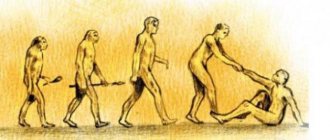Human evolution is built on the totality of the biological and social components of each individual. The individual participates in collective relations based, first of all, on his own priorities. Next, the interests of the family, social group, and people are built. It is impossible to separate the interests of a full-fledged individual from public interests, since a person is shaped by society.
A child raised in a pack of animals, as a result of long therapy and training, will acquire the rudiments of social skills. But there are no proven examples in history where this child could make a significant contribution to the society of his time.
Human progress is based on satisfying the personal desires of each member of society. This is the only way a person contributes to the general database and acquires skills and algorithms for further development. For example, a primitive hunter told his fellow tribesmen where he found prey, counting on his share of future hunting trophies. Or, on the contrary, medieval people jealously kept the secrets of their skills within the family so that a competitor could not take advantage of them.
Accordingly, realizing and realizing his needs and preferences determined by personal traits, a person creates a system of valuable products of a material and spiritual nature, which ultimately fall at the disposal of the entire society. But the basis for individual achievements becomes the entire available complex of developments of society. Starting from fairy tales told by your mother and ending with Internet resources.
The founder of dialectical materialism, Karl Marx, gives the following formulation: “...Man differs from all other animals in the limitlessness of his needs and their ability to expand...”.
Vital needs
The name of this group of needs comes from the Latin vitalis - life.
Among them there are three subgroups: self-preservation, self-reproduction and self-maintenance. Self-preservation needs help maintain the physical integrity of the body: any organism needs nutrients and water. When the diet is imbalanced, the need for individual components of normal nutrition arises (“you want meat”). In addition, any organism strives to avoid mechanical damage and, therefore, anything that can cause it - be it the fangs of a predator, hail or a moving car.
The need for self-reproduction is often called sexual. This is not entirely accurate. In relations between the sexes, as will be shown below, people satisfy several needs at once. Therefore, the sexual need can be easily decomposed into several vital and social needs.
The body's self-maintenance needs are associated with maintaining its functional integrity and maintaining performance. Both animals and humans need constant stimulation of sensory systems - vision, hearing, etc. To satisfy sensory needs, it is not the information load that matters, but the number and variety of stimulation of the sensory organs. An animal whose brain structures where sensory inputs are located is destroyed during the experiment falls into a state indistinguishable from a deep loss of consciousness. The first astronauts experienced mental disorders caused by the lack of familiar sensory information due to gravity. It is known that monotonous blocks of new buildings increase fatigue, worsen mood, cause painful sensations in the chest and stomach, etc. precisely because of their monotony. A person forced to constantly be in such an environment experiences a deficit in sensory influx.
Essentially, the need for information is the development of a need for sensory input. People who come to see the rhinoceros thereby satisfy their need for information. Teachers who can compare note that cadets of military schools are much more inquisitive and diligent than students of regular schools, gymnasiums and lyceums. Probably the fact is that the barracks regime limits both sensory and information flow. Therefore, teenagers, locked for a significant part of the week within the walls of the school, are greedily interested in subjects that they will not have to directly study in their future professional activities, for example, biology.
Both needs (for sensory input and for information) are biologically based in that the constant collection of information about the environment is a vital condition for the survival of every person and animal. This need underlies their exploratory behavior, and its magnitude varies within each species. Both among people and among any species of animals, there are individuals who quickly lose interest in a subject if it is not related to food, safety and other pressing problems. At the same time, both among cats, for example, and among people, there are those who can spend a long time doing things that have no biological significance. It would be more correct to say that they have no actual biological significance. It is unknown how the conditions of existence will change and what properties of things will be important for survival. Therefore, a certain part of the community must engage in nonsense research, from the point of view of the majority, about which they say that it “has no practical significance.”
Sometimes the need for physical activity is highlighted. Indeed, all people have a hard time with immobility. However, this need consists of informational and sensory, since the muscles contain receptors that send information to the central nervous system about muscle contraction and the relative position of the limbs. Thus, during morning exercises, we not only “stretch” the muscular, cardiovascular and respiratory systems, but also activate the central nervous system with a flow of nerve impulses from receptors located in the muscles and internal organs.
The vital need for movement was recently shown in experiments on mice that had free access to alcohol. His consumption was zero. “Squirrel wheels” were installed in the home cages, in which the mice ran for several hours a day. Alcohol consumption remained zero. After the wheels were removed, the mice, deprived of their daily dose of exercise, began to drink alcohol. Its consumption serves as an indicator of mental ill-being. Consequently, daily movement has a beneficial effect on the state of the psyche, and deprivation of the opportunity to move worsens well-being.
The need for emotions is biologically determined by their role in organizing behavior. Usually it is not obvious, since a person who leads an active social or even just a working life (for example, a forester) experiences enough emotions. The existence of a need for emotions becomes obvious if a person’s social contacts are limited due to retirement, illness, etc. In everyday life, television becomes the main source of emotions for such people. The need for emotions is satisfied, in particular, during the play behavior of adult animals and people.
It is easy to see that the three self-maintenance needs mentioned above are closely related to each other. Restricted sensory and information flow leads to emotional disorders. Writers of the 19th century (for example, N. Leskov and Anatole France) repeatedly noted the bad character of monks and nuns. The same thing can be observed today in closed groups (during long-distance expeditions, in garrisons and closed educational institutions) or in holiday villages filled with pensioners (“Put down your cat, which scares our dog”). In conditions of sensory and information hunger, any, even insignificant, event acquires a bright emotional coloring that is inadequate to the significance of this change in the environment. Psychological discomfort in conditions of information hunger can easily turn into mental disorders.
The fourth need for self-maintenance is hedonic, or the need for pleasant sensations. Kozma Prutkov is absolutely right. A conversation with a friend satisfies informational and social needs. Food is not only about satisfying the need for energy and building material for the body, but also about receiving pleasure as a result of taste sensations. The hedonic need is especially effectively satisfied with the help of sweets.
How not to become addicted
Sometimes a person experiences a constant desire that develops into addiction, for example: to eat or sleep a lot. This is facilitated by psychological and physical health problems. There is a whole list of mental illnesses that are associated with food. Such diseases have the abbreviation Eating Disorder, which stands for eating disorder. This includes:
- excessive thinness (anorexia);
- bulimia with unhealthy weight control;
- binge eating;
- desire for healthy and proper nutrition;
- bigorexia.
A specialist will help you cope with such deviations. If you do not contact him in time, additional mental disorders may occur:
- depression;
- neurosis;
- anxiety;
- PTSD.
Excessive appetite also indicates hormonal diseases in the body that occur when taking any medications. If you notice a constant craving for food and this has been going on for a long time, immediately consult a doctor for help. Such a frequent need for food and sleep is a sign of various kinds of psychological or physical disorders. For example, people suffering from chronic health problems need rest more than healthy individuals. However, in a strong body, a condition such as hypersomnia (excessive sleep and the manifestation of constant drowsiness) can occur. It manifests itself after stressful situations, during a long period without relaxation, or when taking medications. It can also occur for the following reasons:
- head injury;
- depression;
- uremia;
- apnea.
In order not to be a hostage to the needs of physiology, listen to your body and prevent alarming signals by contacting a doctor or psychotherapist.
Social needs
This group includes all needs and forms of behavior associated with communication with other creatures, most often with representatives of their own species.
Communication may not be direct, but only imaginary. Yet almost everything we do is done with the existence of other people in mind. Each person belongs to more than one social group and plays different roles in them. The degree of involvement in each of these groups is different, so the basic social need of a person becomes the need for self-identification. Through social self-identification, a person is saved from the fear of loneliness - one of the existential, i.e., problems inherent in all people.
Every person has a need to feel like a member of some community. All human behavior and the inner world of his emotional experiences are built on the basis of identifying himself with a certain group: a family, a specific state, a people, a work team, a fan of a football team, a group on social networks, etc. Sometimes communities are formed according to random, insignificant characteristics. It may be the same surname if it is rare or if it is borne by a prominent person. Or a general illness or even hair color. It is important that coming together as a community improves people's mental well-being. In Vadim Shefner’s story “The Silent Violet,” people with fractures of the right leg were placed in one ward, and those with fractures of the left were placed in another. This was done so that “the patients would have a common topic of conversation.”
At different moments in life, different groups become the most important for a person, that is, his priorities change. As a rule, he identifies himself with the most successful community at the moment.
Often social identification is emphasized by certain attributes. The concept of “uniform honor” was equivalent to the concept of “regimental honor.” Features of clothing were strictly regulated in class society. A person does many things only because “it’s customary” in the society of which he considers himself a member. Behaving in a certain way just because “it’s accepted” is the satisfaction of this need. For example, the Greeks and Romans did not wear pants. This is not always convenient; for example, patients had to wrap cloth around their legs and thighs. But they considered it impossible to use such a practical thing as pants, since for them it was a sign of barbarism. In modern European society, behavioral characteristics, including the choice of costume, also play a huge role in satisfying the need for social self-identification.
A person considers himself a member of some community not because most of the members of this group are somehow attractive to him. In the absence of another group, people consider themselves members of the one that exists. For example, one of the existing definitions of the concept of “relatives” sounds like this: this is a group of completely strangers who periodically gather to drink and have a snack due to a change in their number. In fact, when answering the question: “List 20 people with whom communication gives you the greatest pleasure,” subjects mention no more than two relatives, and these are, as a rule, family members. An analysis of the subjects’ descriptions of their attitudes towards relatives shows that in most cases these people are perceived by them as alien individuals with different interests, a different value system, a different lifestyle and a different sense of humor. Nevertheless, when communicating with relatives at weddings, funerals and anniversaries, a person experiences elation due to the fact that his need for social self-identification is satisfied.
Patriotism is most often based on the self-identification of people as members of metaphysical communities, that is, those who do not have material objects that can serve as a symbol of unity. A classic example of the influence of subjective categories on a completely material development of events is the renaming of streets in besieged Leningrad. Indeed, the fighting was carried out more successfully by people who live in a city where there is Nevsky Prospekt, Sadovaya Street and Palace Square than by residents of a city with 25th October Avenue, 3rd July Street and Uritsky Square.
To satisfy the need for social self-identification, a person must determine which social group is most important to him at the moment. A person’s behavior and the inner world of his emotional experiences are built on the basis of self-identification as a member of a certain group: a family member, a citizen of a particular state, a representative of a nation, a member of a work team, a fan of a football team, etc. A change in self-identification is common. A person unconsciously associates himself with the most successful community at the moment (it’s more pleasant to root for a champion, rather than for an eternal average).
In addition, it is very important how comfortable a person feels in a given community. Once in Germany, a librarian heard me counting out pages in a low voice near the copy machine in Russian and started talking to me. She left Czechoslovakia in the early 1970s. (after the 1968 occupation) and among other things she said something that surprised me: “We hated you (Russians) so much, but now we miss you so much.” We can conclude that this woman never managed to integrate into German society. She identifies herself as “a resident of the countries of the socialist community.”
The need for friendly relationships is one of the social needs. Direct physical contact (hugs, patting, stroking, etc.) is present in relationships between close people. We can observe similar behavior in many animals - this is the so-called crowding and mutual cleaning.
Some social needs are transformed into artificial ones, which is most clearly manifested in the prices of art objects. A painting can hang for decades until some expert discovers that it was painted not by an unknown artist, but by a famous one. The price of the canvas will immediately increase hundreds of times. Neither the artistic nor the historical value of the piece of art has changed, but now people are willing to pay huge amounts of money for it. At the heart of this phenomenon is their need for vanity.
Regular satisfaction of social needs is as necessary for human health as vital ones. But the fundamental difference between social needs and vital needs itself is that to satisfy the former, the presence of other people is necessary - human society, society.
Mental disorders of children, deprived for one reason or another of the opportunity to satisfy social needs, prove the vital importance of the latter. An example would be the so-called unfrustrated children, who are raised without denying them any request or prohibiting anything. When they grow up, they experience more than just communication problems. They typically experience a range of cognitive and emotional disorders. This is explained by the fact that in childhood they were deprived of the opportunity to satisfy the child’s natural need to “follow the leader.”
What is the difference
The main difference between the concepts under consideration is that needs are unsatisfiable, and needs are satiable. This means that a person needs food, water, shelter throughout his life. This is what makes needs unsatisfiable.
In this case, needs, as a rule, can be satisfied once. If you purchase a specific product or receive a specific service, a person will stop feeling the need for it for a certain period of time or forever.
Expert opinion
Karnaukh Ekaterina Vladimirovna
Graduated from the National University of Shipbuilding, majoring in Enterprise Economics
Today, the issue of classifying human desires as needs or wants is considered very controversial. This also includes the desires of society, because, in fact, it is an integral part of human life. Moreover, a specific individual can live without society. Moreover, this will not lead to negative consequences. Similar nuances apply to love, the birth of children, and intimacy. For some people this may be a vital need, but for others it may be an ordinary need.
The concepts under consideration are given one of the central places in social science, philosophy, law and other sciences. This is due to the fact that they are key factors in human existence. The image and meaning of life, the goals and aspirations of a person, his attitude towards society and other people in it are based on them.
At the same time, it is extremely important to be aware of your own desires. It is important to identify the differences between the positive and negative sides and achieve what you want.
Ideal Needs
Only humans have ideal needs.
They arose relatively recently. For example, Aristotle included the “desire for knowledge” among the ideal needs that distinguish humans from animals. It must be distinguished from the need for information, which manifests itself in animals in exploratory behavior. Even a laboratory rat, living in the same cage for several months, periodically walks around all the walls, intensely moving its whiskers. It is human nature to try to comprehend the cause of things, and not just the laws of the surrounding world. For example, a domestic cat tries to get food. Empirically, she quickly establishes that in order to satisfy her nutritional needs, she must rub her forehead against the leg of the person living with her. But where does fish come from, and especially boiled fish, the cat is not concerned with such questions. Since the need for knowledge is not found in all people, sometimes the needs that distinguish a person from an animal include the need not for knowledge, but for self-knowledge: as Chilon of Laconia said, “know yourself.”
In the remaining needs, which are usually classified as ideal, as a rule, it is possible to identify components that are other needs. For example, the need for religion is determined, in particular, by the need for social self-identification, that is, to belong to a certain limited community of people, which differs from other human communities in a number of external characteristics. In addition, in religious feelings there is also the realization of the need to submit to the leader, who is responsible for everything that happens:
Atheists are forced to admit that all the troubles that happen to them are their own fault. At the very least, a person is an accomplice in the overwhelming number of incidents that bring him grief. It is not evil people, not a fatal coincidence of circumstances and, of course, not God’s providence that are to blame for a person’s troubles and misfortunes, but only himself. This conclusion is not easy to accept. Therefore, a variety of worldview systems are constantly emerging and will continue to emerge, performing the main function of religion - transferring a person’s responsibility for his life to external circumstances.
Ideal sometimes also includes needs that do not increase the viability of the individual itself or the community to which it belongs. In particular, informational and social needs are considered ideal if they dominate over the needs of self-preservation.
comparison table
The main features and differences of the concepts under consideration are given in the table:
| Criterion | Need | Need |
| Scope of terms | It is considered a fairly broad concept, and need is part of it. | On Maslow's pyramid of needs, only the bottom 2 steps are allocated for needs. |
| Significance | It represents goods without which human life is difficult, but possible. | It appears in the form of a primary object, which cannot be avoided. |
| Appearance | It is subjective in nature and appears in the human consciousness. | Differs in objective existence. The presence is due to human nature itself. |
| Relativity | They happen exclusively to people – creatures with highly organized consciousness. | They occur in any living creature - both people and animals. |
Application in marketing
In marketing, Maslow's pyramid serves as a starting point for finding target audiences and segmenting them, as well as for market analysis. Based on data received from users, specialists can find out what needs prevail among the target audience.
For example, the user cannot place an order for a long time - perhaps there are some fears - and the specialist needs to be told about the guarantees. Or show the valuable qualities of a product that will help improve its comfort: cooking equipment, an alarm system to protect the home, a Parker pen as an indicator of a person’s success and wealth.
Important! The pyramid is a material for reflection that will help you understand the big picture, but not solve a specific problem.
Thanks to the concept, it is possible to plan long-term goals in order to track the dynamics of changes in the needs of the audience and see them. That is, the company can predict demand, develop a strategy and assess risks. And for each segment, work out the corresponding product.
For example, a consumer is looking for a vacuum cleaner. It follows the classic customer journey:
- The first stage: “Manifestation of need.” It compares the characteristics and cost of the product.
- The second and third are “Interest” and “Research”. After the buyer has become familiar with the brand, he studies the warranty terms and delivery information.
- The fourth is “Purchase”. Purchase of goods.
- Fifth - “Return” or “Manifestation of need”. After the purchase, a person may discover a defect or breakdown - and either the company will solve this problem, or he will continue to search. At all stages, the buyer experiences different needs.
Why satisfy a need?
A. Maslow listed desires from bottom to top. Since only when the lowest level is satisfied can one move on to the next one. Spiritual and social needs are necessary and important, but when feeling hungry and lack of sleep, the individual will show indifference to them. In the Middle Ages, such schemes were specifically used by dominant tyrants and generals. They believed that an individual suffering from hunger was easier to control than a well-fed one.
Unsatisfied biological desires deprive the possibility of thinking, rational reasoning, striving for freedom, and achieving goals. Therefore, keeping your body in good shape, constantly paying attention to it and fulfilling all requests is an important rule for full functioning in life.











